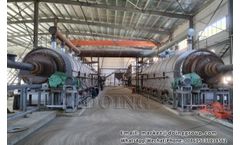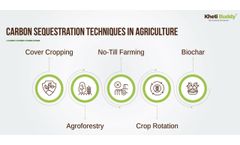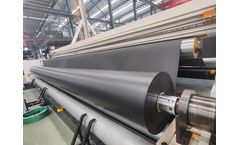Refine by
Soil Fertility Articles & Analysis: Older
215 articles found
Enhancing Soil Fertility One of the primary benefits of biochar is its ability to improve soil fertility. ...
Their contributions to water conservation, crop protection, soil health and automation have revolutionized traditional farming practices, increasing efficiency, productivity and sustainability. ...
Its porous structure and chemical properties make it highly effective for soil improvement and environmental benefits. Agricultural practices in developing countries often face hurdles such as: Soil Degradation: Continuous farming and overuse of chemical fertilizers deplete soil nutrients. ...
Derived from agricultural waste biomass, biochar not only provides a sustainable way to manage waste but also serves as an effective soil amendment, enhancing soil fertility and sequestering carbon. Understanding how biochar is made and recognizing its benefits is essential for harnessing its potential across agricultural and environmental ...
It can not only be used as a clean energy to replace traditional coal and reduce environmental pollution, but also as a soil conditioner in agriculture to improve soil fertility and crop yields. ...
Agricultural Enzymes Agricultural enzymes, sourced from microorganisms like fungi and bacteria, are catalyst that accelerates the chemical reaction that unblocks the nutrients present in the soil, and helps increase crop production, soil fertility, and food protection. The most commonly used enzymes in plant growth and soil ...
As global agricultural practices address environmental and economic challenges, regenerative agriculture has stood out as a promising approach to creating more sustainable and robust farming systems. This farming method focuses on restoring soil health, enhancing biodiversity, and improving water cycles, ultimately leading to more sustainable food production. Innovative tools and technologies are ...
Charcoal production is a vital industry with diverse applications, ranging from fuel to soil enhancement. Sawdust and wood chips are two primary raw materials for making charcoal, and understanding their properties, benefits, and processing methods is crucial for optimizing production. 1. ...
Agricultural Enzymes Agricultural enzymes, sourced from microorganisms like fungi and bacteria, are catalyst that accelerates the chemical reaction that unblocks the nutrients present in the soil, and helps increase crop production, soil fertility, and food protection. The most commonly used enzymes in plant growth and soil ...
This transformation hinges on effective carbon sequestration techniques, which capture and store atmospheric carbon dioxide in soils and plants. Implementing these methods is crucial in our fight against climate change. ...
They can improve soil fertility, promote the growth and reproduction of microorganisms in the soil, improve the agricultural productivity of soil and improve the environment for plant growth. ...
Agricultural Enzymes Agricultural enzymes, sourced from microorganisms like fungi and bacteria, are catalyst that accelerates the chemical reaction that unblocks the nutrients present in the soil, and helps increase crop production, soil fertility, and food protection. The most commonly used enzymes in plant growth and soil ...
Wine grape production is both art and science and proper soil and vine nutrition is essential for top production of high-quality wines. In this field test, AZOMITE was added as a single spring-time application to the soil fertilizer program at a leading winery. AZOMITE was applied by banding the product along the side of each row of vines. ...
The basic principle behind crop rotation is alternating the types of crops grown in a particular field over time to improve soil fertility, control pests, and maximize yields. In traditional crop rotation systems, farmers would typically divide their land into several plots or fields and rotate different crops through each plot on a regular schedule. For ...
Detection Technologies of Soil Fertilizer The detection of soil fertilizer is mainly to detect the chemical elements contained in it, and the most content is nitrogen, phosphorus and potassium. ...
The anti-seepage engineering of manure tanks in cattle farms is very important, and geomembrane is a commonly used anti-seepage material. In the construction of manure tanks in cattle farms, geomembranes can effectively prevent manure leakage, thereby avoiding problems such as groundwater pollution and soil erosion. When choosing a geomembrane, you need to consider the following aspects: ...
Whether used for cooking, heating, or electricity generation, biomass charcoal offers a sustainable alternative to fossil fuels, reducing reliance on non-renewable energy sources and mitigating greenhouse gas emissions. 3. Soil Amendment and Carbon Sequestration Biochar, a form of charcoal produced through the pyrolysis of biomass, serves as a valuable soil ...
Its porous structure creates a habitat for beneficial soil microorganisms, contributing to soil health and fertility. Nutrient Retention: Biochar has a high cation exchange capacity (CEC), enabling it to retain nutrients such as nitrogen, phosphorus, and potassium in the soil. ...
In this article, we explore the wonderful uses of bamboo biochar in poultry farming and its potential to revolutionize the industry.Soil Amendment and Nutrient Retention Bamboo biochar serves as an excellent soil amendment, enhancing soil structure, fertility, and nutrient retention capacity. ...
A review of various surveys on the state of agriculture revealed a connection between low crop yields, reduced incomes, and soil fertility constraints, particularly soil acidity. Additionally, a lack of awareness about soil health and fertility management resulted in the indiscriminate use of input treatments. ...








